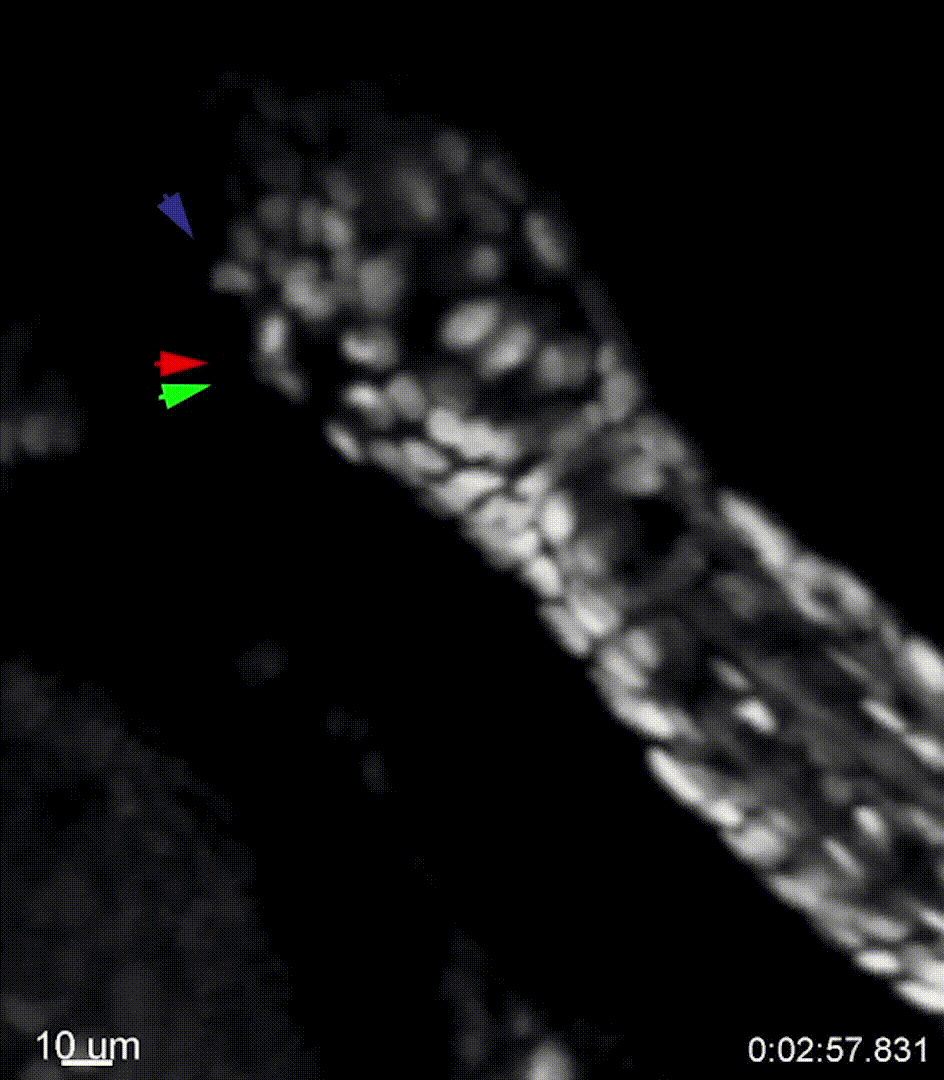Scientists showed that hair loss happens partially as a result of stem cells escaping from hair follicles. They also shot a stunning time-lapse video of the process.
The stem cell cycle
Stem cells reside in “stem cell compartments” in various tissues. By differentiating into multiple types of cells upon demand, they contribute to tissue regeneration. Stem cell exhaustion is one of the hallmarks of aging.
In the hair, the stem cell compartment, known here as the bulge, is adjacent to the hair follicle. Hair growth happens in three phases: anagen, catagen, and telogen. During anagen, the hair grows due to the stem cells rapidly dividing and differentiating. Catagen is the intermittent state when the hair growth slows down, and many cells undergo mitosis arrest (halting of division) and apoptosis (cell death). This leads to telogen, the resting phase when not much is happening until the old hair is pushed out of the follicle, and the new cycle begins. During aging, the telogen phase gets longer and longer – the so-called “telogen retention” [2].
Rogue stem cells caught on camera
It is extremely hard to monitor stem cell activity in live animals over time, yet this is exactly what the researchers have achieved using noninvasive imaging techniques based on lasers. What they saw amazed them: by anesthetizing the animals from time to time and putting them inside the imaging device, they were able to observe and record the process of stem cells escaping the bulge. This escape happens during the prolonged telogen phase and probably constitutes a previously unknown mechanism of hair aging.

The researchers studied both young and old mice. In young animals, the bulge was well defined, and epithelial cells, including the stem cells, were restricted to their rightful place – the epithelium – at all hair cycle stages. On the contrary, in many older mice, the researchers noticed the shrinkage of the hair follicle and the bulge. The shrinkage was more pronounced when the bulge showed signs of stem cell escape.
How do they escape?
The “rogue” stem cells escape to the dermis, which is the lower layer of the skin, separated from the epithelium by a thin layer of cells called the basement membrane. Since the researchers had only labeled epithelial cells, they were not able to directly observe the membrane. Instead, they saw escaping stem cells change their shape and shoot out of the bulge as if squeezing through tight, invisible holes, which are most likely structural abnormalities in the membrane. The researchers hypothesize that aging somehow harms the structural integrity of the membrane, but this phenomenon demands further examination.
Epithelial cells should also be held together by cellular adhesion and the integrity of the extracellular matrix (ECM). If cells are able to escape, things are probably not going well in that department either. The researchers looked for proteins that were downregulated in the follicles that experienced stem cell escape, zeroing in on two of them: transcription factors FOXC1 and NFATC1. These proteins are indeed known to regulate cellular adhesion and ECM integrity. Further experiments showed that young stem cells cluster much better due to stronger cellular adhesion, while old stem cells appear more scattered and looser.
The scientists then created genetically modified mice with both FOXC1 and NFATC1 knocked out and found that these animals demonstrated even more pronounced symptoms than the older controls, including massive hair loss. Shrinking of hair follicles and stem cell escape were detected as well. Although the researchers did not study the effect of the upregulation of FOXC1 and NFATC1, they suggest that such upregulation could potentially alleviate age-related hair loss.
These findings seem to support an idea that has been gaining popularity in the longevity field: that the integrity of the extracellular matrix might be a much more crucial factor of aging than previously thought.
Cancer alert!
The researchers noticed that, as the cells escaped to the dermis, they did not undergo differentiation and remained stem cells. They also seemed to be doing quite well in the new environment, at least for the time being. Interestingly, this is not a good sign, since stem cells are known to contribute heavily to tumorigenesis [3]. The authors call for more research into the role that escaping stem cells might play in the development of cancer.
Conclusion
Not only does this paper reveal a new potentially reversible mechanism of hair loss, it also pioneers a noninvasive imaging technology that allows scientists to observe aging on the cellular level in live animals. While hair loss is largely harmless, if regrettable, this research can potentially help us understand more fundamental mechanisms of aging and maybe shoot some amazing time-lapse videos in the process.
If you enjoyed this story, you may also enjoy this related video by the Lifespan News team.Literature
[1] Zhang, C., Wang, D., Wang, J., Wang, L., Qiu, W., Kume, T., … & Yi, R. (2021). Escape of hair follicle stem cells causes stem cell exhaustion during aging. Nature Aging, 1-15.
[2] Reddy, S. K., & Garza, L. A. (2014). The thinning top: why old people have less hair. Journal of Investigative Dermatology, 134(8), 2068-2069.
[3] Reya, T., Morrison, S. J., Clarke, M. F., & Weissman, I. L. (2001). Stem cells, cancer, and cancer stem cells. Nature, 414(6859), 105-111.





